Apple varieties old and new
I grow more than fifty varieties of apples on vertical cordons against a forty metre long fence in the vegetable garden. And another twenty varieties trained horizontally as step-overs on low strung wire. They range from the ancient French apple Court Pendu Plat, which has been cultivated for at least four hundred years, to such modern apples as the New Zealand selection, Gala. The first apple to ripen in the garden is Vista Bella, which is always ready to pick on New Year’s Day, and the last is Rokewood which I leave on the tree until June. I can pick ripe apples every day for nearly six months of the year.
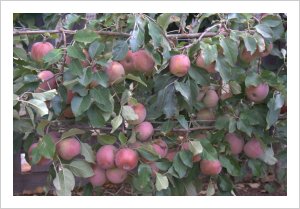 I can grow so many varieties in such a small space because the rootstocks that they are grafted on to are dwarfing. It is the rootstock which determines the size of the apple tree. It doesn’t matter what the variety is that is used as a scion if the rootstock is a dwarf one then the apple tree will be dwarf.
I can grow so many varieties in such a small space because the rootstocks that they are grafted on to are dwarfing. It is the rootstock which determines the size of the apple tree. It doesn’t matter what the variety is that is used as a scion if the rootstock is a dwarf one then the apple tree will be dwarf.
During the first third of the twentieth century English scientists at the East Malling Research Station did invaluable research on apple rootstocks. This work has been the rock on which modern commercial apple production has been built. Several dwarf rootstocks were selected and tested and the best of these are still used today.
When Criss and I first bought this property twenty years ago the first apples I planted were grafted on Granny Smith seedling rootstocks. The trees grew so big and were so tardy in producing fruit that I pulled them out after a few years and started again. I was lucky that a friend who had a huge collection (some eight hundred odd different accessions) of apples lived nearby and he was happy to graft the varieties I wanted. We used two different rootstocks, M9 and M27.
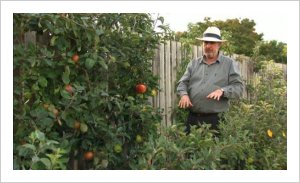 |
| David indicates the 'step-over' height |
The trees grafted on M27 have been trained horizontally on two strands of low wire. This way of growing trees is called step-over as the wires can be strung so low that the trees can be stepped over. The trees are spaced 160cm apart. The one problem with this rootstock is that the fruit tends to be quite small although that’s not a disadvantage though if you have lots of young grandchildren as I do. Fruiting is incredibly prolific if modern varieties are used. So much so that an astonished Japanese visitor looking at a Fuji smothered in fruit remarked that “It’s all apple and no tree.”
The trees grafted onto M9 stocks are grown against a 180cm high paling fence. Every 90cm thick bamboo stakes are fixed to wire strung along the fence. The apple trees are tied vertically to these stakes.
I was born in a horticultural village in the East Midlands which in the late forties and early fifties still had some wonderful 19th century orchards. The trees were huge, some eight metres tall by nearly as much wide. For much of the year cows grazed beneath them or in smaller orchards the chooks were allowed to forage.
The main variety grown at that time was Bramley’s Seedling, which was first discovered in the nearby cathedral town of Southwell. This apple is a cooking variety. When baked the flesh becomes silky and frothy. When stewed it makes a delicious puree with a wonderful sharp flavour. Bramley’s Seedling stored well in England and kept for six months after it was picked.
My parents who had a small orchard used to store apples in the attic where they were placed carefully on the floor each one given a little space so that they didn’t touch each other. As the attic was also my bedroom apples scented my dreams throughout my childhood and adolescence.
The apple I most loved then was Golden Harvey which has the most unprepossessing looking fruit you could imagine. It dates back to the 17th century. It is described in The Book of Apples by Morgan and Richards as “Small, golden, russeted. Intensely flavoured, sweet-sharp, quite aromatic.” It was a popular eating apple in England during Victorian times but it wasn’t grown commercially after the 1890s because the fruit was too small and possibly too ugly with its rough warty skin. I grow this variety here and it is the one apple that I keep for myself.
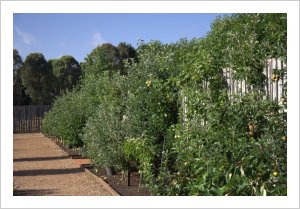 Of the other old varieties that I grow here I would recommend a Ballarat apple variety called Stuarts Seedling. It’s quite late ripening and I don’t start picking it until early May and it isn’t at its best until mid-May. It has a really good acid-sugar balance being both sweet and slightly tart. It keeps well if kept in a cool spot and is still good to eat in late winter. I have a large old tree of this variety but it only bears every second year. Grafted onto a dwarf rootstock it bears every year.
Of the other old varieties that I grow here I would recommend a Ballarat apple variety called Stuarts Seedling. It’s quite late ripening and I don’t start picking it until early May and it isn’t at its best until mid-May. It has a really good acid-sugar balance being both sweet and slightly tart. It keeps well if kept in a cool spot and is still good to eat in late winter. I have a large old tree of this variety but it only bears every second year. Grafted onto a dwarf rootstock it bears every year.
There are so many beautiful looking apples but the prize for good looks goes to Grand Duke Constantine. It has a rosy pink skin with an alluring bloom. It is also a remarkably big apple. A few years ago my grandson took one to kinder for show and tell and his teacher easily fed all the kids with it.
Other successful old varieties that produce a reasonable crop of decent apples includes:
Blue Pearmain which has a blue bloom. I pick it in March but it is better for a month’s storage which allows the flesh to become aromatic, soft and creamy.
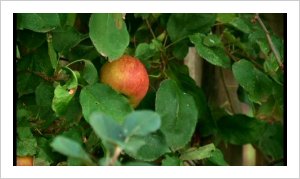 |
| Belle de Boskoop |
Belle de Boskoop is a Dutch variety which was first grown in 1856. It is excellent cooked, keeping its shape well for tarts, but also making a good tangy flavoured golden puree which barely needs any sugar.
Fameuse is the old snow apple so popular when I first arrived in Australia but now very rarely seen. At its best the pure white flesh is crisp, juicy and sweet but it can be disappointing some seasons.
A nursery in Beaufort, which is quite close to us, sells many of the old varieties of apple on dwarf rootstocks www.heritagefruittrees.com.au
The most productive apple varieties are modern ones. These can be very ordinary in the super markets because so many apples now-a-days are picked unripe. Picked ripe off your own trees they become something else.
Golden Delicious picked ripe is a great eating apple, crisp juicy and with an aromatic flavour. It keeps its shape when cooked and so is good for tarts.
Gala is an early apple with rich flavour, crisp and juicy and has the advantage of storing well for a few months. Gravenstein, which ripens at the same time, is delicious but only for a week or two and then it becomes flat and floury.
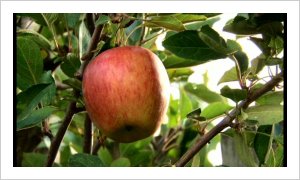 |
| Braeburn |
Braeburn is one of the best during its March season. It’s crisp and has good sweet-tart balance. I find it gets bitter pit and so I give it a handful of dolomite lime every couple of years.
Cox’s Orange Pippin is a fabulous apple if the weather is cool for two weeks before its mid-March ripening period. Sadly this only happens every five years or so.
Granny Smith is usually treated as a cooking apple but if it is allowed to fully ripen on the tree, which is when it is flushed with yellowish green in mid-May, it is luscious, juicy and sweet making it a joy to eat as long you peel the tough skin first.
Jonathon shouldn’t be forgotten even if it has been sold unripe by supermarkets for so long. Picked ripe it is “....crisp, juicy, sweet with plenty of refreshing acidity....” It doesn’t store well with me and I eat it within a few weeks of ripening.
Several commercial nurseries are now growing modern apples on dwarf rootstocks. Your local garden centre should be able to help.
My wife, Criss Canning, says that you can taste the sun in the apples you eat straight from the tree.